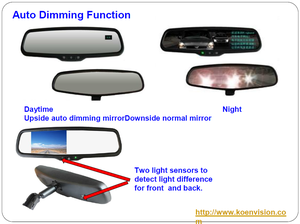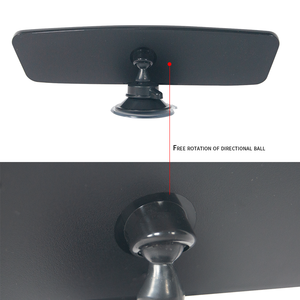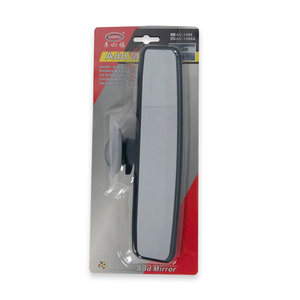(51345 products available)






















































































































































































































































Auto rearview mirrors are an essential part of vehicle safety and convenience. These mirrors are available in various types, each designed to meet different needs and preferences. Below are the types of auto rearview mirrors.
The specification of the auto rearview mirror is as important as the actual part itself. It helps business buyers understand the features of various auto rearview mirror types. The following are some common specifications to expect:
Material
The material used to make the rearview auto mirrors can affect their performance and durability. Common materials include glass and plastic. Glass is scratch-resistant and provides clear visibility. On the other hand, plastic is shatterproof, lightweight, and less expensive.
Size and Shape
Auto rearview mirrors come in various sizes and shapes. The size should be suitable for the vehicle without obstructing visibility. Standard sizes for interior rearview mirrors range from 4 to 6 inches in width. The shape can be round, rectangular, or teardrop-shaped.
Magnification
Some rearview auto mirrors have a slight magnification to enhance visibility and reduce blind spots. The level of magnification should be clearly specified.
Mounting Type
The auto rearview mirror is mounted with either adhesive or a pedestal clip. Mirrors mounted using adhesive are easier to install but are more difficult to remove. Pedestal-mounted clips are more secure.
Coatings
Various coatings are applied to the glass of rearview auto mirrors to enhance their features. For instance, anti-glare coatings minimize reflection. Also, scratch-resistant coatings enhance the durability of the mirror by preventing scratches.
Auto-Dimming
Some rearview mirrors have auto-dimming features. This feature is particularly useful in rearview mirrors that are also monitors. The mirror automatically dims itself when it detects bright light, like from headlights. It ensures the driver is not blinded by the light.
Integrated Technology
Besides the auto-dimming feature, other technologies can be integrated within the rearview auto mirrors. For instance, some mirrors come with built-in displays for GPS navigation or a backup camera. Voice control features are also available in some auto rearview mirrors.
Shatterproof
Some rearview auto mirrors have a shatterproof feature. The glass is treated to prevent shattering in case of an accident, ensuring the passengers' safety.
Auto rearview mirrors need regular maintenance to ensure they function well and last long. Here are maintenance tip:
When buying auto rearview mirrors, business buyers need to consider various factors to ensure they meet consumer needs. These factors include the material of the rearview mirror, its size and design, and the type of mirror coating it has.
The material of the auto rearview mirror is important. It determines the longevity and durability of the mirror. Common materials that suppliers use to construct rearview mirrors are glass and plastic. Glass is a better choice when looking for durability and scratch resistance. It offers a clear view and doesn't distort images. Plastic is lightweight and less prone to breakage. It is a safer option for baby car rearview mirrors.
The size and design of the rearview mirror also affect the choice. Larger mirrors offer a wider field of view. However, they are more likely to obstruct visibility, and the driver may not be able to open the sunroof. Besides size, the design of the rearview mirror matters. Some are frameless, and others have a frame. Frameless mirrors give a good view because they don’t have a border to obstruct the reflection.
The type of mirror coating also affects the choice of an auto rearview mirror. Anti-dazzle and anti-glare rearview mirrors are coated to reduce glare, especially in bright daylight or when driving at night and facing oncoming traffic. These rearview mirrors increase the comfort and safety of drivers. Apart from anti-glare coatings, some rearview mirrors have a blue tint. They help to reduce glare but at the expense of visibility because the tint can obscure the view.
Besides the coatings, buyers should consider whether the rearview mirrors are manual or electrochromatic. Manual rearview mirrors are the basic types. They require the user to adjust them manually. Electrochromatic rearview mirrors are powered by a battery. They automatically adjust to changes in light, making them convenient for the user.
Convenience features such as homelink, memory settings, and automatic dimming are worth considering. Auto rearview mirrors with memory settings are more expensive because they offer a customized setting for different drivers. Automatic dimming rearview mirrors are also more expensive. They are suitable for luxury vehicles.
Additionally, business buyers should check the quality of the auto rearview mirrors. Those that are quality tested by relevant authorities are a better choice. They are more desirable because end users prefer auto rearview mirrors that will last and give value for money.
The car rearview mirror is easy to replace, even for first-time DIYers. All the technician needs is a replacement auto rearview mirror, a screwdriver, and adhesive. Follow these simple steps to get it done:
Q1. What are the differences between auto convex mirrors and other types of rearview mirrors?
A1. The primary difference between convex and other types of glass rearview mirrors is the surface. Convex mirrors have a surface that curves outward. As a result, they provide a wider field of view. However, objects in the mirror may appear smaller than they are, making them farther than they actually are. On the other hand, auto-rearview mirrors have flat surfaces that show the actual size of objects but a reduced field of view.
Q2. Do convex auto rearview mirrors only get used for side-view?
A2. No, convex mirrors can be used in any application where a wider field of view is needed without having to look straight at the mirror. While they are commonly used for side views in vehicles, convex mirrors can also be utilized in other situations. These include areas where visibility is crucial, such as parking lots, busy intersections, and even in some cases, blind spot mirrors.
Q3. Can convex auto rearview mirrors be used for convex mirrors for a blind spot?
A3. Yes, convex mirrors are well-suited for blind spot applications because of their ability to provide a wider field of view. They can be installed on the existing side mirrors to help drivers see areas they typically can't check directly. This can reduce the risk of accidents when changing lanes or merging into traffic.
Q4. What materials are used to make convex auto rearview mirrors?
A4. Convex auto rearview mirrors are typically made using glass or plastic. Glass mirrors offer good optical clarity and durability. However, they are more likely to break on impact. On the other hand, acrylic and polycarbonate convex mirrors are shatterproof and less likely to break on impact. They are more suitable for high-risk environments. However, they may not offer the same level of optical clarity as glass.
Q5. Can convex auto rearview mirrors be installed manually?
A5. Yes, convex auto rearview mirrors can be installed manually. Some are designed to be attached to existing side mirrors using adhesive or brackets. Installation is typically a straightforward process that requires basic tools. However, it's essential to follow the manufacturer's instructions carefully to ensure proper placement and alignment.